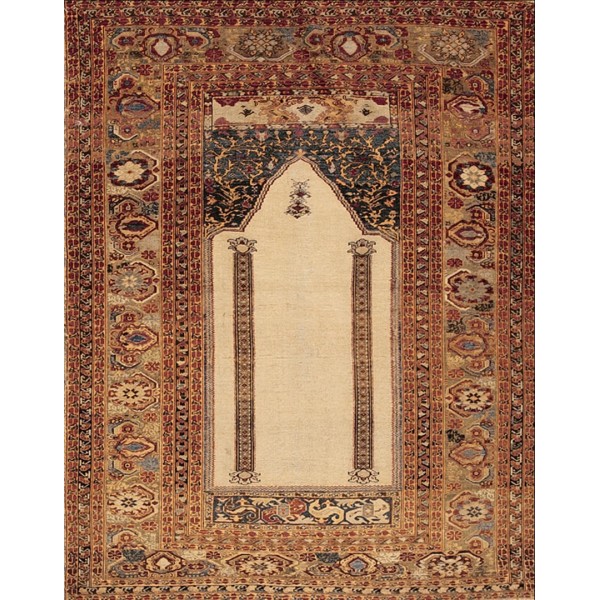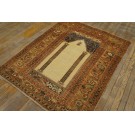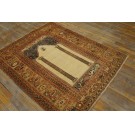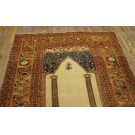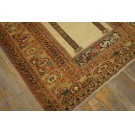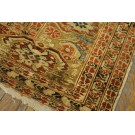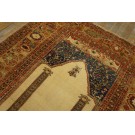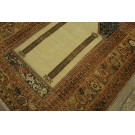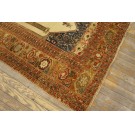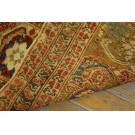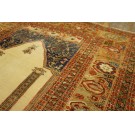Mid 18th Century Turkish Ghiordes Prayer Carpet
Ghiordes Prayer Rug
Western Anatolia
Mid-18th Century
Warp: wool, beige, natural, z-2-s
Weft: wool, beige, natural, Z-1 with a few Z-2; cotton selvage wefts penetrate into rug body about 1” average
Pile: wool, z-spun; or cotton, off white only, z-spun
Knot: symmetric (Turkish), horiz. 12 x vert. 17 = 204/sq. inch. Alternate warps depressed mostly 0 degrees, some up to 30 degrees.
Sides: original light blue silk overcast mostly lost; cotton 2 cord selvage on single body warps
Ends, both: wool plain-weave, ecru-beige, averaging about 5/8:”
All materials are handspun.
This western Anatolian urban niche-design rug shows an open ivory-ecru field with lateral free floating columns with lotus palmette bases and capitals. The niche is characteristically shouldered and pointed at the apex. A small compound of three lozenge elements is set below the apex instead of the usual lamp. The slanted sides of the niche are stepped. The columns show chains of lozenges in mosaic patterns. The vertical sides of the niche are closely serrated, as is the bottom. The drawing of the columns is particularly crisp and sharp. The rug has been woven inverted so that the point of the niche can be centered more easily. At each end of the field is an additional panel. The upper shows small stylized plants in hooked lozenges, while the blue lower panel features sharp lazy S’s. The abrashed blue spandrels show angular ecru arabesques, with a row of tulipoids along the top.
The main border shows palmettes alternating with rosettes within partial leaf brackets, with small secondary accent rosettes. The six minor stripes feature a flip-flop carnation band, four “apple” stripes and a trapezoidal meander with short buds.
There are diagonal lazy lines throughout, indicating the presence of more than one weaver. This is a standard Turkish workshop practice.
Ghiordes rugs were woven generally in the single niche format with a few single row saphs. Clearly they were woven for an affluent clientele, probably consisting of Ottoman administrators, military officers, wealthy merchants and for foreign export as well. A few period Ghiordes carpets are also found in non-niche formats. Many upper class Ottomans had special rooms set aside in their dwellings for prayer and it is assumed that these rugs were woven for that use, rather than to be taken to the mosque for Friday services. A single European painting of the period exists in which a finely knotted, probably Ghiordes, rug is under the feet of a dignitary, while others pray on a coarsely woven Oushak saph. The relatively large numbers of generally well-preserved antique Ghiordes prayer rugs, compared to their pictorial appearance, strongly implies that these rugs, even if carried by a servant/slave, were only infrequently used in public prayer and were more likely confined to private prayer in which case they would be well-preserved.
Our example is in very good condition for the age and shows no repairs. There has been almost no selective color corrosion The end weaves show fragmentary later additions. The original blue silk overcast is mostly perished and the cotton under-selvage has split, but the rug is complete in all directions. All-in-all, a very attractive, naturally dyed, example of a classic Ottoman Turkish period rug in outstanding condition.
Western Anatolia
Mid-18th Century
Warp: wool, beige, natural, z-2-s
Weft: wool, beige, natural, Z-1 with a few Z-2; cotton selvage wefts penetrate into rug body about 1” average
Pile: wool, z-spun; or cotton, off white only, z-spun
Knot: symmetric (Turkish), horiz. 12 x vert. 17 = 204/sq. inch. Alternate warps depressed mostly 0 degrees, some up to 30 degrees.
Sides: original light blue silk overcast mostly lost; cotton 2 cord selvage on single body warps
Ends, both: wool plain-weave, ecru-beige, averaging about 5/8:”
All materials are handspun.
This western Anatolian urban niche-design rug shows an open ivory-ecru field with lateral free floating columns with lotus palmette bases and capitals. The niche is characteristically shouldered and pointed at the apex. A small compound of three lozenge elements is set below the apex instead of the usual lamp. The slanted sides of the niche are stepped. The columns show chains of lozenges in mosaic patterns. The vertical sides of the niche are closely serrated, as is the bottom. The drawing of the columns is particularly crisp and sharp. The rug has been woven inverted so that the point of the niche can be centered more easily. At each end of the field is an additional panel. The upper shows small stylized plants in hooked lozenges, while the blue lower panel features sharp lazy S’s. The abrashed blue spandrels show angular ecru arabesques, with a row of tulipoids along the top.
The main border shows palmettes alternating with rosettes within partial leaf brackets, with small secondary accent rosettes. The six minor stripes feature a flip-flop carnation band, four “apple” stripes and a trapezoidal meander with short buds.
There are diagonal lazy lines throughout, indicating the presence of more than one weaver. This is a standard Turkish workshop practice.
Ghiordes rugs were woven generally in the single niche format with a few single row saphs. Clearly they were woven for an affluent clientele, probably consisting of Ottoman administrators, military officers, wealthy merchants and for foreign export as well. A few period Ghiordes carpets are also found in non-niche formats. Many upper class Ottomans had special rooms set aside in their dwellings for prayer and it is assumed that these rugs were woven for that use, rather than to be taken to the mosque for Friday services. A single European painting of the period exists in which a finely knotted, probably Ghiordes, rug is under the feet of a dignitary, while others pray on a coarsely woven Oushak saph. The relatively large numbers of generally well-preserved antique Ghiordes prayer rugs, compared to their pictorial appearance, strongly implies that these rugs, even if carried by a servant/slave, were only infrequently used in public prayer and were more likely confined to private prayer in which case they would be well-preserved.
Our example is in very good condition for the age and shows no repairs. There has been almost no selective color corrosion The end weaves show fragmentary later additions. The original blue silk overcast is mostly perished and the cotton under-selvage has split, but the rug is complete in all directions. All-in-all, a very attractive, naturally dyed, example of a classic Ottoman Turkish period rug in outstanding condition.
| Stock ID: | #24516 |
| General Rug Type: | Turkish Village |
| Specific Rug Type: | Ghiordes |
| Circa: | 1750 |
| Ground Color: | Ivory |
| Border Color: | Olive |
| Origin: | Turkey |
| Material: | Wool & Cotton |
| Weave: | Pile - Knotted |
| Shape: | Rectangle |
| Width: | 3' 10" ( 117 cm ) |
| Length: | 5' ( 152 cm ) |
DescriptionGhiordesThe town of Ghiordes in Western Turkey has been making rugs for most of 4 centuries. Best known and most desirable are the finely knotted prayer rugs, often with open fields in blue, green, red or ivory, in weaves up to 250 knots per square inch. These are all 18th century and a few early, non-prayer format larger carpets are known. In the 19th century the weave became coarser and large carpets up to 25 square were woven for commercial sale. The type was most popular among collectors in the early 20th century and has recently become of interest to the connoisseur. | |
| Tearsheet Download | |
